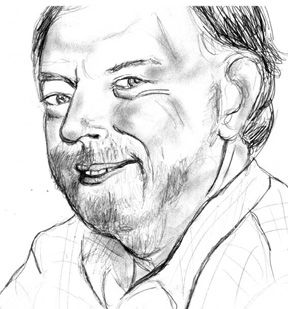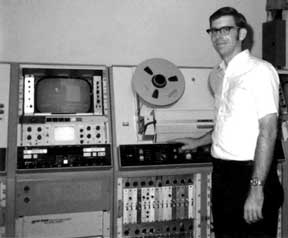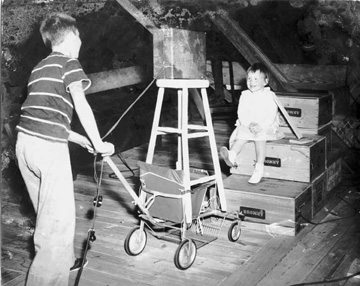Paragon
The word "paragon" means a model for excellence. The men and women you'll see in this feature will be just that: role models we can all look up to for the highest in professional standards and practices. While it is fashionable these days to win notoriety with infamy, we prefer to celebrate the opposite end of the spectrum. So in Paragon, we will honor the people in our creative community whose contributions large or small have helped make our business stronger, kinder, or just plain more interesting. Paragon candidates can come from any walk of creative life; all they have to do is walk on water. To nominate your own Paragon, please send a brief description of your candidate's sterling qualities to gary@ozonline.tv.

Paragon

by Gary Powell
Illustration by Christina Horm
Ken Chambliss was three years old when the light bulb went off, figuratively and literally. World War II was going full tilt, and in those days, by necessity, the simplest pleasures were the greatest. A close family friend came to Chambliss’ childhood home and gave him a small kit with a battery, a small switch, and a light bulb. Hours of on-off-on-off, works-that-way-doesn’t-work-that-way gave rise to an enduring interest in electronics, and tinkering.
Today, in a time of relative peace and prosperity, Ken Chambliss sits in his corner office atop one of the most technologically advanced editing and
finishing facilities keeping up with 55 employees. He is the founder and President of VTA, Inc., known until only a few years ago as Video Tape Associates. Perhaps videotape is slowly becoming passé. VTA, however, is not: it can handle just about any form of moving media that needs to be chopped, colored, fixed, enhanced, or converted.
Still, after years of building, striving, inventing, and playing, it’s still the simple things that appeal to Chambliss. “I like to tinker” is one of his favorite statements. Says Chambliss, “In the mornings when I come to work, I like to make the rounds and say hello to the clients.” Simply stated, Ken Chambliss has been in the broadcast production business for some 40 years, and he is still having fun.Before we tell a bit more about his story, let us make note of just a few of the endeavors and accomplishments that make the man an
Oz Paragon. Anyone who has worked in film and video production and
post production has most likely worked with Chambliss. You may not
have worked directly with him, you may have never visited VTA, but you can give credit to Chambliss for some of your good work.
If you laid hands or eyes on the da Vinci unified color correction technology, you were working with something that Chambliss and his staff invented and manufactured originally some 30 years ago. Ever work on a telecine? You can thank Chambliss and his Steadi-Film Corporation for making your life much easier. Their steadi-film gates have been an industry standard for real time telecine operation since the mid-1990’s. Almost every telecine in the world
has a Steadi-Film product attached to it. Chambliss and his research and
development team at Steadi-Film continue to push the
patent envelope.
Not bad for a stringbean kid from Columbus, GA who had to come home one day, hat in hand, and tell his mother and father that he would not be finishing college anytime soon.
THE BLUEPRINTS WERE NOT WORKING
Pictures moving through the air on television captured Chambliss' young imagination when he was five or six years old. Through his school years he built and operated Ham radios and CB radios. In 1958, Chambliss was telling his high school counselor, "I want to learn about TV." Sometimes, the seeds of success are carried around in a pocket protector, which is really an irreverent way of saying that somebody has a spectacularly inquisitive mind.
With input from his counselor and his parents, and still wanting to learn about TV, Chambliss ended up in college studying electrical engineering. After about two years, he decided that drawing electrical blueprints for new homes was not moving him toward his goal of working in TV. He hopped in his ’49 Buick, drove back to Columbus, and let his parents know that he was quitting college. Not an easy task for a bright young man from a good, middle class family. His father was a solid work-a-day manager for a meat distribution company, his mother was an educator who came from a family of educators. Hand
wringing and serious discussion was followed by promises to get a job and to get back into college, and to do it soon. That blueprint, however, would
also be seriously altered.
LIFE BECOMES BLACK AND WHITE

Chambliss soon landed a job at Columbus TV station WRBC. He was hired to run camera from 2 p.m. through the 11 p.m. news every day. A year into his job, he was promoted to the engineering department. Chambliss was at master
control the day Walter Cronkite interrupted all local broadcasts to announce that President John F. Kennedy had been assassinated.
As with many things throughout his life, it was fortuitous that WRBC was the first station in Georgia to use videotape. As with all things TV, Chambliss was fascinated by tape. Back then, videotape was two inches wide, black & white, and prone to manufacturing artifacts and mistakes. Chambliss was part engineer, part videotape editor. Editing, back then, was equal parts alchemy and surgery. Sprinkle iron oxide powder on the tape, identify the pulse points, slice with a razor blade, and tape it back together. In the mid-60’s the station upgraded to a color capable tape to tape Ampex editing machine. Still, the station never upgraded to color cameras until after Chambliss left in 1966.
It was in that year that Chambliss almost suffered the
consequences of breaking the finishing college promise. Though he was taking courses, he was not taking enough hours for deferment from the Vietnam War draft. He rode in a bus full of other inductees from Columbus to Atlanta. In the Army's induction building on Ponce de Leon Avenue near the old Sears building, Chambliss failed his physical. Asthma as a child disqualified him from service. Physically and
spiritually, Chambliss flew home to Columbus that day.
LIVE FROM SOUTH BEACH
It was time for a change. After the relatively safe black and white world of mid-60’s Georgia, Chambliss opted for the full color of South Miami Beach, FL. Chambliss says, “I loved water skiing, snorkeling, and scuba diving.” He wrote to the three network affiliates in Miami to inquire about employment. The NBC affiliate, WCKT had just started broadcasting in color, and they needed
somebody with Ampex editing machine experience. Chambliss was their man. He ended up building their tape department.
Opportunity is always knocking for people willing to work hard enough to open the door. For Chambliss, South Beach offered numerous freelancing opportunities. He freelanced on the Jackie Gleason Show, among others. And there were always corporate gigs, medical conventions, and other TV shows. Soon, he was freelancing in Palm Beach on a game show, “Treasure Isle.” The show was taped on two islands in the middle of a huge lagoon that was part of a brand new hotel. The show ran on ABC immediately following the hugely popular Bewitched, and Chambliss was responsible for taping and editing the show and the Treasure Island “tags” that ran during Bewitched. The host of the show was John Bartholomew Tucker, who went on to great voiceover fame as the voice of the Pink Panther in the Owens-Corning fiberglass commercials, as well as numerous other national spots. Chambliss also worked freelance on “Let’s Go to the Races” for Bing Crosby Productions. During this show’s run, he spent nearly every day at the racetrack, but still managed to keep life and career on track.
Not long into his day job and freelancing career, the light bulb went off for Chambliss again. All the equipment used on shows originating from south Florida was based in New York: cameras, editing equipment, and production trucks. He went to work on his business and financing plan. Chambliss learned as much as he could about the business of broadcast and incorporated it into his business plan. For Chambliss, the business side of the plan was the easy part. The tough part was finding bankers back then who understood broadcast and its potential.
BY THE BOOTSTRAPS 101

Chambliss was specifically looking for deposit money for his equipment and some working capital. He got it in 1968. He ended up borrowing money from his father, his brother, and cashing in his own savings. His long and inquisitive relationship with Ampex paid off with equipment being sent to him without as much as a credit check. A few legal formalities later and Ken Chambliss was the founder and President of Video Tape Associates of Florida, Inc. He rented a small space in south Florida and spent six to eight months just building, By this time, he was a husband and a father.
He kept his family going with money he had saved from his freelancing days.
Says Chambliss, "Bing Crosby paid well!"
VTA took delivery of two 2" Ampex video tape recorders and a revolutionary electronic editing system. It was
revolutionary because it allowed the operator to edit with buttons instead of razor blades … and because it utilized time code technology. During this time, Chambliss made several strategic decisions about the shape and direction of his business.
The first involved the production side of the broadcast business. TV cameras were very expensive, even in 1969 dollars, $100,000 per camera. In addition to expensive cameras, production required large studio spaces. Finally, and in Chambliss’ own words, "I really liked editing." As a result, he focused on working with a production partner rather than trying to build his own
production business. That partner was Media Research & Productions, soon to be known as Miami Teleproductions. Among the founding members of that company was a former radio DJ Dan Chandler, known now in the Atlanta
production community for his voiceover work. The second decision would shape a great deal of his future business and
inventiveness. Commercials would continue to be shot on film for TV. They would always need to be transferred to tape, and they would always need to be color corrected. Chambliss decided he would fill those needs.
BIG BREAKS, LONG HOURS
About the time Chambliss got his new equipment and facility up and running, along came Robert Whitney and his new psychedelic rock show, "The Now Explosion." The show was originally based in Atlanta. After some partnership and ownership disputes, Whitney brought the show's assets from Atlanta to Florida - via Alabama so he could avoid the police roadblocks waiting for him in Georgia. The new production offices happened to be just down the hall from Chambliss' new company. The syndicated, ten hour show featured
different rock groups performing with very abstract and groovy graphics. Before each song, a DJ would do his piece. The first DJ was "Skinny" Bobby Harper, who also had a life as a successful rock DJ in Atlanta, a voiceover talent for Delta Air Lines, and a MARTA Public Relations officer.
Each performance came in on a separate videotape. These tapes, together with the DJ bits, had to be transferred to a master, duplicated, and then shipped to the stations that purchased the syndicated show. Chambliss did the job. With only two machines and a steep learning curve, the first ten hour show took over 200 hours to master. As the process streamlined itself,
however, it only took 15 hours to crank out a 10 hour show.
These were heady days. The director of the show was R. T. Williams, who later became the Director of Production for WTBS about the time it hit the satellite and became SuperStation. A couple of the cinematographers for the show were young kids, about 15 or 16. "They were not even old enough to drive yet." These two brothers have also become very well known in Atlanta's
creative community: Cinematographer Bill Wages and Creative Director and Designer Bob Wages.
Opposed to this fast paced work was some really fun work in slow motion broadcast. Broadcast pioneer and creator of ABC’s Wide World of Sports, Roone Arledge, revolutionized sports broadcasting with the advent of
immediate playback of slow motion shots. Chambliss spotted an opportunity. At the time Chambliss acquired his Ampex HS-100 slow motion machine, there were only six in the world. The demand was immedate, it was rented every weekend. Soon, Chambliss and VTA had an annual contract with CBS for slow motion sports broadcasting. Chambliss added another slow motion machine and covered football and basketball, pro and college,
all over the states. "Every Thanksgiving, I had Thanksgiving lunch at 5:00 a.m.," says Chambliss of his frequent visits to Detroit, MI to help CBS broadcast the Detroit Lions football games. He and his slow motion equipment also attended several SuperBowls.
The company also developed a reputation as an excellent duplicator. Back in the day, it was not uncommon to have videotape stock that contained random manufacturing flaws. Tape was evaluated by recording the entire tape in color bars … and then watching the entire tape to check for defects. Cape Canaveral contracted with VTA to supply pre-evaluated tape for tape delay broadcast of Apollo missions. Hand in hand was the ability to duplicate quality tape. One day, one of Chambliss’ contacts from the Let’s Go to the Races show approached him to duplicate and distribute an important, new syndicated show, Paul Harvey. Long before satellite, VTA made a name for itself mastering, duplicating, and distributing syndicated content.
BACK TO GEORGIA
In 1977, after steady growth in Miami and deciding that VTA was “as big as it was going to get” in Florida, Chambliss established an Atlanta presence. The Miami office had grown to two edit suites, an audio suite, duplication facilities, a studio, and remote truck. The Atlanta office opened with much of the same.
Many readers personally know some of VTA’s long lasting employees. Jodi Arminio started in Atlanta as a switchboard operator in 1977. Glenn Martin has been Marketing Director since 1980. They, however are babies … Mike McNally is VTA’s General Manager and due for retirement next year. He began his VTA career in 1970. The list goes on, and one of the measures of Chambliss and his work is the number of employees who have significant longevity. Longevity, in and of itself, may not mean much. Longevity coupled with the obvious success of the business and those involved, however, is a legacy.
Steadily, Chambliss began to learn and feel that market forces were changing, and Atlanta soon began drawing more and more of his attention. He moved himself, his family, and “corporate” to Atlanta. Soon, the stress of regular commutes to South Florida coupled with increased opportunities in Atlanta convinced Chambliss to sell the South Florida division to the local managers. VTA then purchased 5 acres in Atlanta, where they built their current facility with input from many of his clients. Clients wanted the new building light and airy, with the ability to walk out of an edit and actually see the weather. And, they wanted to eat. What seems de rigueur for a post house these days was leading edge when built: VTA had a kitchen and dining area.
In 40 years of working in production and post production, Ken Chambliss has not lost a step. A tour of the facility is a peek at all the leading edge transfer and post technologies. If that’s not enough, step down to the basement where the research and development team continues to push the
technology with Chambliss' input. Helpful and discerning dissertations on emerging technologies areavailable; he does not prattle.
Still, Ken Chambliss has been working hard for 40 years, and he has built a great deal of professional and financial success for himself. On the day of the interview, he appears in a green shirt with festive, red, holiday
suspenders. He is at ease, relaxed in the way that only a man with both a
history of and a present filled with success can be. With his close cropped white beard and glint in his eye, it is hard to not to think of the man as a toy maker in Santa's workshop.
As the stories and memories unfold, he motions for the visitor to walk with him out of his main office and around a corner into a smaller office, more like a cubby hole. Papers, folders, computers, and odds and ends are stacked and strewn everywhere. Chambliss reaches and rummages a bit, and then shows off a museum piece from the past or a little something to illustrate a point he is making about the future. Talking with him about film and video production and post, one gets the same feeling as you would get from learning to fish from your kindly grandfather. Ken Chambliss is a man that likes to tinker.
|

